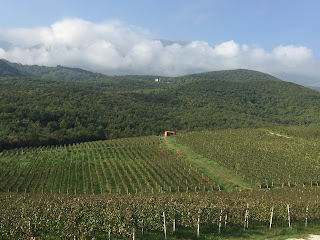We had arrived early for a vineyard tour and tasting and had been welcomed by the aforementioned Stellios and Lambros Papadimitriou (Director of Sales and Marketing). We were to be joined by a group of Austrian Somms but they had been up late tasting with the Naoussa producers. No worries. We decided to proceed and they would join in upon arrival.
 |
| Stellios Boutaris, Winemaker and CEO, Kir-Yianni |
 |
| Lambros Papadimitriou, Dir., Sales and Marketing, Kir-Yianni |
 |
| Vineyard around Kir-Yianni winery in Naoussa |
After some dialogue in the area outside the vineyard, and on the winery portico, we repaired to a conference room for a more detailed presentation and a tasting of the wines.
The Naoussa vineyard was bought by Boutari -- the leading Greek wine brand -- in the 1960s and had a number of managers before eventually being managed by Yiannis Boutaris between the 1970s and 1990s. In 1997 Yiannis spun off two of the enterprise's most prominent vineyards to form Kir-Yianni with the goal of creating a "super-premium" Greek wine estate. Yiannis was joined by his son Stellios who took over the reins in 1999.
As intimated previously, Kir-Yianni has holdings in both the Naoussa and Amyndeon appellations. The Naoussa vineyard (55 ha) is in the area of Yiannakohori, in the northern part of the appellation and was originally planted in the 1960s. There have been three stages in its development:
Early 19790s
- Planted with 50 ha of Xinomavro
- Trained vertical shoot positioning
- Much of the vineyard uprooted and replanted with Merlot and Syrah
- Believed to be suited to the microclimate of the region
- Believed to give great results when combined with Xinomavro
- 15 ha replanted with Xinomavro and other Greek and international varieties
The Naoussa vineyard produces big reds from Xinomavro (50%), Merlot (20%), Syrah (15%), Cabernet Sauvignon (10%), and other experimental varieties.
We did not visit the Kir-Yianni Amyndeon vineyard but our understanding is that it is 18 ha in size at 700 m altitude. In addition to owned grapes, Kir-Yianni controls an additional 40 ha through contractual agriculture. The varieties planted in Amyndeon include Xinomavro, Roditis, Malagousia, Syrah, Merlot, Chardonnay, Sauvignon Blanc, and Gewurtztraminer.
A total of 18 wines were presented for the team to taste: two sparkling wines (one of which was a rosé); four whites; one rosé; three red blends; and eight Xinomavro reds. Stellios had indicated that Greeks love Sauvignon and Sauvignon Blanc blends and half of the white wines reflected a bow to that market reality. In general, blends play a significant role in the estate's offerings: excluding a single-vineyard Sauvignon Blanc and the Xinomavro wines, all of the remaining wines are blends. This focus on blends reflects another reality of the marketplace as related by Stellios: they operate in a brand-driven local market.
The estate began making a sparkling wine 5 years ago and today have two of these wines on the market. The Paranga sparkling is a blend while the Akakies sparkling is 100% Xinomavro. Both are made via the Charmat method, an approach which may be questioned in light of the comparatively stellar sparkling wines produced by Domaine Karanika in similar terroir conditions in Amyndeon.
As regards the Xinomavro wines, the estate's strategy is to produce a new generation of Xinomavro products and, to that end (according to Yiannis Karakassas MW), are employing clones that provide better ripeness in the fruit. The staples that were presented to us were one PDO each from Naousa and Amyndeon and a Xinomavro (with a small dose of Syrah) labeled PGI Imathia. In addition, we were allowed to taste four unreleased wines made from single-block grapes and one single-block wild ferment.
At the conclusion of the tasting we went back out onto the portico for a snack and some more wine.
All in all, an insightful visit.
****************************************************************************************************
Whites
Paranga Sparkling (Roditis-Malvasia-Xinomavro) -- Pleasant; pleasing fresh fruit and residual sugar balanced by bright acidity; drying finish; spiciness.
Paranga White/Petra 2014 (Roditis 80% - Malagousia 20%) -- Melony, white fruit character; lees richness; citrus rind; white stone fruit.
Ktima Kir-Yianni Samaropetra Vineyard 2014 (Roditis 50% - Sauvignon Blanc 50%) -- Peach; rich, tropical notes; rich lees; citrus; broad-based.
Tesseris Limnes 2014 (Chardonnay 60% - Gewurtztraminer 40%) -- Tropical notes; bitter acidity; weighty.
Droumo 2014 (Single Vineyard Sauvignon Blanc) -- Not aromatic; broad-based acidity; balanced; more of an old world style.
Red Blends
Paranga 2013 (Merlot 50% - Xinomavro 25% - Syrah 25%) -- Oak, bright stemmy fruit; cocoa; semi-bubble-gum character; phenolic; barky.
Ktima Kir-Yianni Yianakohori Hills 2012 (Xinomavro 50% - Merlot 30% - Syrah 20%) -- Elegance; black fruit; soft; round; non-complex with medium finish.
Dyo Elies (Syrah 60% - Merlot 30% - Xinomavro 10%) -- dark fruit; front-loaded; good acidity; tannin bomb.
Rosé
Akakies Rosé 2014 (Xinomavro) -- Dark rose color; strawberry; weighty with high acidity.
Reds
Kali Riza 2013 (PDO Amyndeon Xinomavro Old Vines) -- Tomato, red cherries; bright tannins; good acidity; balanced.
Ramnista 2011 and 2005 (PDO Naoussa Xinomavro) -- More muted on nose; spicy; more vegetal character but more elegance. The 2005 exhibited some more developmental characteristics to include truffles and kerosene.
Ramnista Siniatsi (block 9) 2011 (PDO Naoussa Xinomavro) -- Fresh on nose; leather; big acidity; lighter color than block 15.
Ramnista Cyclamina (block 15) 2011 (PDO Naoussa Xinomavro) -- Dark fruits; plumminess; spice; hint of dates and stewed fruit.
Ramnista LImni (block 5) 2011 -- More robust on the nose with a little mintiness; great palate feel; vegetality; beautiful wine.
©Wine -- Mise en abyme




No comments:
Post a Comment